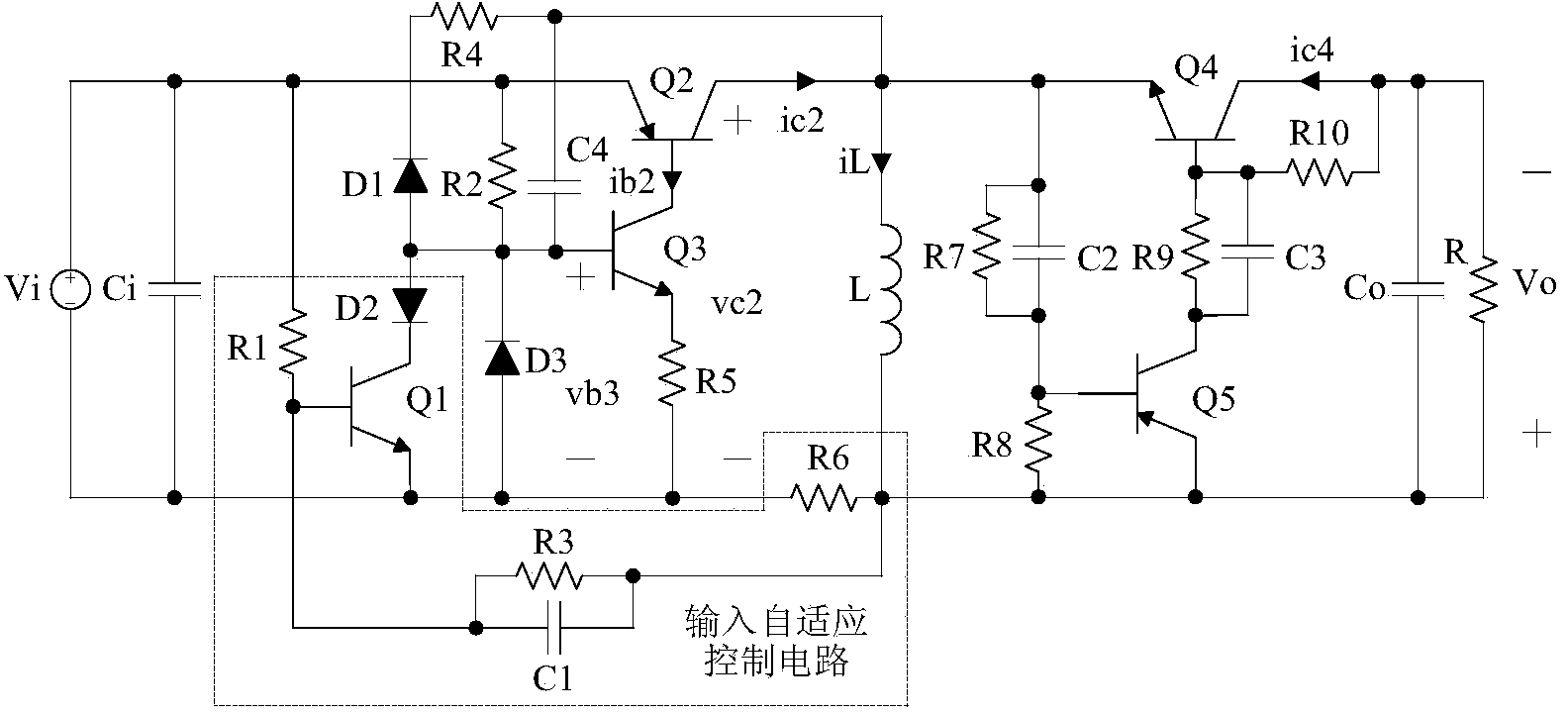Input adaptive auto-excitation type Buck-boost converter
A self-adaptive, converter technology, applied in the direction of converting DC power input to DC power output, output power conversion devices, instruments, etc., to achieve the effect of reducing freewheeling conduction loss and small current detection loss
- Summary
- Abstract
- Description
- Claims
- Application Information
AI Technical Summary
Problems solved by technology
Method used
Image
Examples
Embodiment 1
[0035] refer to image 3 , Embodiment 1 includes a main loop and an input adaptive control circuit for adaptive current limiting protection, and the main loop includes an input capacitor Ci, an inductor L, a PNP type BJT transistor Q2, an output capacitor Co, and is used to drive a PNP type BJT The driving circuit of the tube Q2 and the freewheeling sub-circuit for reducing the freewheeling conduction loss. The drive circuit includes NPN type BJT tube Q3, resistor R2, resistor R4, resistor R5, diode D1, capacitor C4 and diode D3, and the input adaptive control circuit includes NPN type BJT tube Q1, diode D2, resistor R1, resistor R3, capacitor C1 and resistor R6, the freewheeling sub-circuit includes PNP type BJT tube Q5, NPN type BJT tube Q4, resistor R7, resistor R9, resistor R8, resistor R10, capacitor C2 and capacitor C3. The role of diode D3 and capacitor C4 is to improve the switching speed of NPN type BJT tube Q3, the role of capacitor C3 is to improve the switching sp...
Embodiment 2
[0044] refer to Figure 5 , Embodiment 2 On the basis of Embodiment 1, the diode D3 is omitted, and a Zener tube Z is added. The cathode of the Zener tube Z is connected to the base of the NPN type BJT tube Q3, and the anode of the Zener tube Z is connected to the DC voltage source Vi The negative terminal is connected, and the Zener tube Z has the function of widening the working range of the circuit.
[0045] refer to Figure 6 , The working principle of the circuit of embodiment 2 is similar to that of embodiment 1, and also has an input adaptive current limiting function. Within a steady-state working cycle (t21 to t23), the working state of Embodiment 2 in the critical continuous mode of the inductor current iL can be roughly divided into two stages: the t21 to t22 stage and the t22 to t23 stage. The main difference lies in: when the embodiment 2 is in the period from t21 to t22, the base voltage vb3 of Q3 is equal to the reverse conduction voltage drop VZ of the Zener ...
PUM
 Login to View More
Login to View More Abstract
Description
Claims
Application Information
 Login to View More
Login to View More - R&D
- Intellectual Property
- Life Sciences
- Materials
- Tech Scout
- Unparalleled Data Quality
- Higher Quality Content
- 60% Fewer Hallucinations
Browse by: Latest US Patents, China's latest patents, Technical Efficacy Thesaurus, Application Domain, Technology Topic, Popular Technical Reports.
© 2025 PatSnap. All rights reserved.Legal|Privacy policy|Modern Slavery Act Transparency Statement|Sitemap|About US| Contact US: help@patsnap.com



